Discover 15 hidden attractions, cool sights, and unusual things to do in Burgos (Spain). Don't miss out on these must-see attractions: Burgos Cathedral, Cartuja de Miraflores, and Abbey of Santa María la Real de Las Huelgas. Also, be sure to include Castillo de Burgos in your itinerary.
Below, you can find the list of the most amazing places you should visit in Burgos (Castile and León).
Table of Contents
Burgos Cathedral

Also known as: Catedral de Burgos
13th-century Gothic place of worship. The Cathedral of Saint Mary of Burgos is a Catholic church dedicated to the Virgin Mary located in the historical center of the Spanish city of Burgos. Its official name is Santa Iglesia Catedral Basílica Metropolitana de Santa María de Burgos.
Its construction began in 1221, in the style of French Gothic architecture and is based on a Latin Cross. After a hiatus of almost 200 years, it went through major embellishments of great splendor in the 15th and 16th centuries: the spires of the main facade, the capilla del Condestable, 'Chapel of the Constable' and dome of the transept. These are elements of the flamboyant Gothic which gives the cathedral its unmistakable profile. The last works of importance (the Sacristy or the Chapel of Saint Thecla) were performed in the 18th century, during which the Gothic portals of the main facade were also modified. The style of the cathedral is the Gothic, although it has several decorative Renaissance and Baroque elements as well. The construction and renovations were made with limestone extracted from the quarries of the nearby town of Hontoria de la Cantera.
Many works of extraordinary artists are preserved in the cathedral, bearing testimony to the creative genius of architects and sculptors of the Colonia family (Juan, Simón and Francisco), the architect Juan de Vallejo, sculptors Gil de Siloé, Felipe Bigarny, Rodrigo de la Haya, Martín de la Haya, Juan de Ancheta and Juan Pascual de Mena, the sculptor and architect Diego de Siloé, the fencer Cristóbal de Andino, the glazier Arnao de Flandes and the painters Alonso de Sedano, Mateo Cerezo, Sebastiano del Piombo or Juan Ricci, among others.
The design of the main facade is related to the purest French Gothic style such as found in the contemporary great cathedrals of Paris and Reims, while the interior elevation refers to Bourges Cathedral. The facade consists of three stories topped by two lateral square bell towers. The spires, showing Germanic influence, were added in the 15th century by Juan de Colonia. The portals of Sarmental and la Coronería were constructed in 13th century Gothic style, while the portal de la Pellejería shows 16th century Plateresques-Renaissance influences.
The cathedral was declared a World Heritage Site by UNESCO on October 31, 1984. It is the only Spanish cathedral that has this distinction independently, without being joined to the historic center of a city (as in Salamanca, Santiago de Compostela, Ávila, Córdoba, Toledo, Alcalá de Henares or Cuenca) or in union with other buildings, as in Seville. It is similar in design to Brussels Cathedral.[1]
Address: Plaza Sta. María, 09003 Burgos
Cartuja de Miraflores
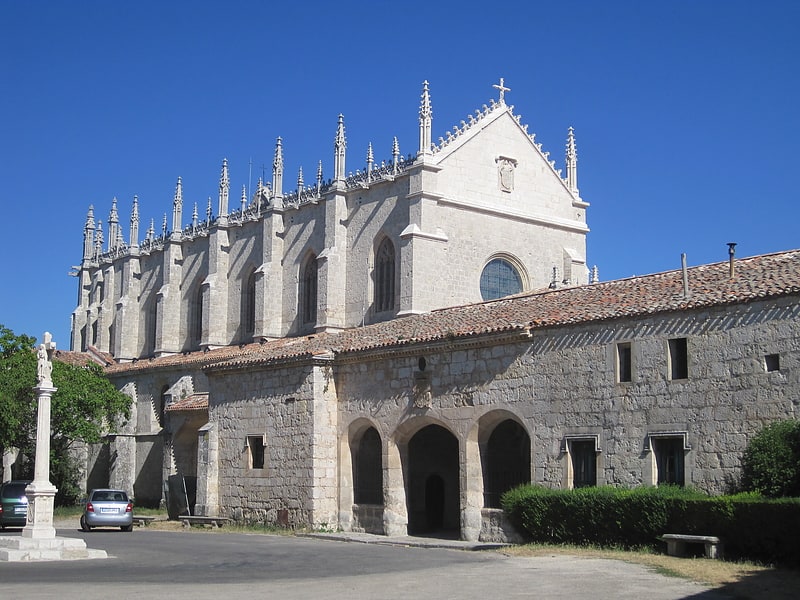
1400s monastery with golden altarpiece. Miraflores Charterhouse is an Isabelline style charterhouse, or Carthusian monastery of the Order of the Carthusians, built on a hill about three kilometres from the center of the Spanish city of Burgos, autonomous community of Castile and León.
Its origin dates back to 1442, when King John II of Castile donated a hunting lodge outside Burgos, which had been erected by his father Henry III of Castile "the Mourner" in 1401, to the Order of the Carthusians for its conversion into a monastery, thus fulfilling his father's wishes, as stated in his will. A fire in 1452 caused the destruction of the pavilion, and construction of a new building began in 1454. It is this building, which was placed under the patronage of Saint Mary of the Annunciation, which exists today. The construction was commissioned to Juan de Colonia, and was continued after his death by his son, Simón de Colonia, who completed the structure in 1484 at the behest of Queen Isabella I of Castile, surviving daughter of king John II of Castile and queen Isabella of Portugal, whose impressive buried are housed in the monastery.
It is a late-Gothic jewel, and its highlights include the church, whose Isabelline style western facade is decorated with the coats-of-arms of its founders. The monastery consists of a single nave with stellar vault and side chapels, and is topped by a polygonal apse.[2]
Address: Calle Cartuja de Miraflores, 09002 Burgos
Abbey of Santa María la Real de Las Huelgas

Also known as: Monasterio de las Huelgas
1100s royal convent for guided tours. The Abbey of Santa María la Real de Las Huelgas is a monastery of Cistercian nuns located approximately 1.5 km west of the city of Burgos in Spain. The word huelgas, which usually refers to "labour strikes" in modern Spanish, refers in this case to land which had been left fallow. Historically, the monastery has been the site of many weddings of royal families, both foreign and Spanish, including that of Edward I of England to Eleanor of Castile in 1254, for example. The defensive tower of the Abbey is also the birthplace of King Peter of Castile.[3]
Address: C. Bernardino Obregón, 3-5, 09001 Burgos
Castillo de Burgos
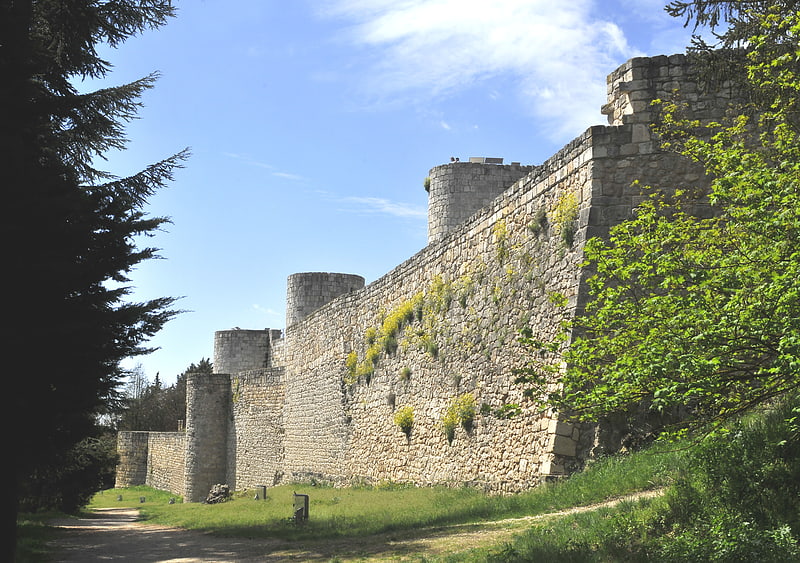
Castle in Burgos, Spain. The Castle of Burgos was a castle and alcázar, located in the city of Burgos, in the hill of San Miguel to 75 metres above the city and to 981 metres above the sea. This hill was the subject of archaeological surveys by General Centeno in the years 1925 and 1926 trying to find Napoleonic military files from when the French in their retreat blew up the fortress. According to the results obtained in this excavation the origin of the castle dates to the Visigoths, and its oldest parts, to the Romans.
The castle grew over the centuries, becoming a major fortification and residence of the kings of Castile. Following the accession of the Habsburg family the castle lost its importance as a royal residence, and during the French occupation, on June 15, 1813, the French army decided to leave the Castle of Burgos, and they destroyed it with explosives. The explosion resulted in the almost total destruction of all the castle grounds. The castle remains in ruins.[4]
Address: Cerro de San Miguel, Burgos
Museum of Human Evolution
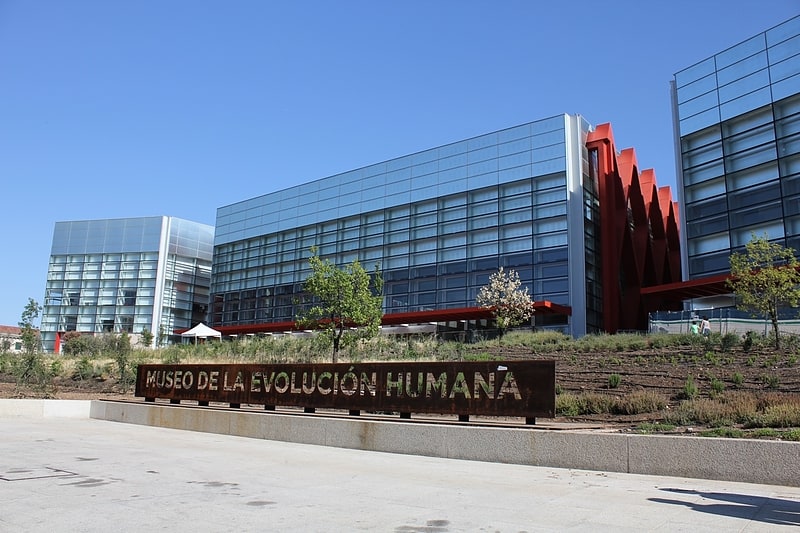
Also known as: Museo de la Evolución Humana
Museum in Burgos, Spain. The Museum of Human Evolution is situated on the south bank of the river Arlanzón, in the Spanish city of Burgos. It is located roughly 16 kilometers west of the Sierra de Atapuerca, the location of some of the most important human fossil finds in the world. In addition, the Archaeological site of Atapuerca, which was declared a World Heritage Site in 2000, has yielded some of the exhibits at the museum.
It forms the centerpiece of the so-called "Complejo de la Evolución Humana" (Human Evolution Compound), comprising a convention center, the CENIEH research institution, and the museum itself.[5]
Address: Paseo Sierra de Atapuerca s/n, 09002 Burgos
San Nicolás de Bari

Catholic church in Burgos, Spain. Iglesia de San Nicolás de Bari is a Catholic church on Fernán González street in Burgos, Spain, located next to the Camino de Santiago, behind the Cathedral of Burgos. It is mainly known for having one of the largest altarpieces in Spain and the only one carved in limestone.
Since the Church of San Esteban was turned into a museum, it has served as the seat of the parish of San Esteban.[6]
San Esteban

Catholic church in Burgos, Spain. Iglesia de San Esteban is a former Catholic church in Burgos, Spain, on the eastern perimeters of Burgos Castle. It was essentially built between the late thirteenth and early fourteenth century. It now houses the Museo del Retablo.[7]
Address: Calle San Esteban, 1, 09003 Burgos
Iglesia del Carmen
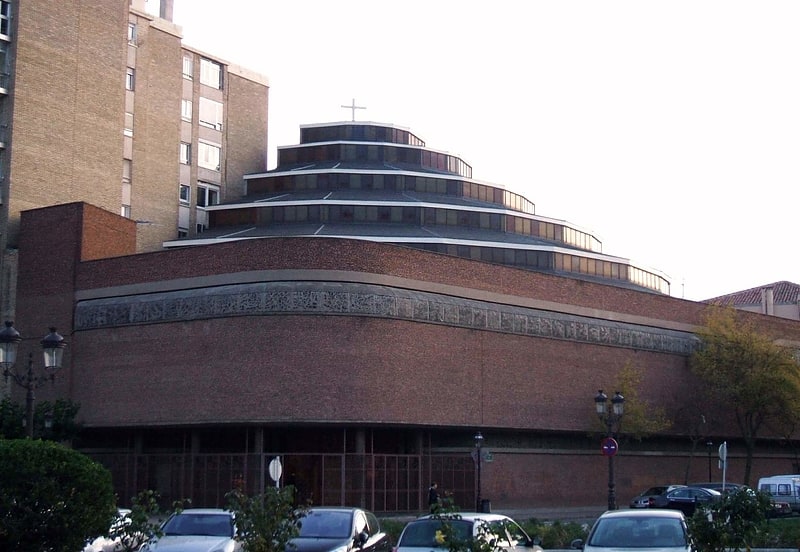
Parish church in Burgos, Spain. The Iglesia del Carmen de Burgos is a Catholic parish church built in Burgos, Castile and León, Spain. It is a modern building, built in 1966–1968, replacing a demolished baroque building. It is located at the intersection of Paseo del Empecinado with Calle del Carmen, between the Arlanzón River and the old railway. The church was inaugurated on 7 July 1968.[8]
San Lesmes Abad
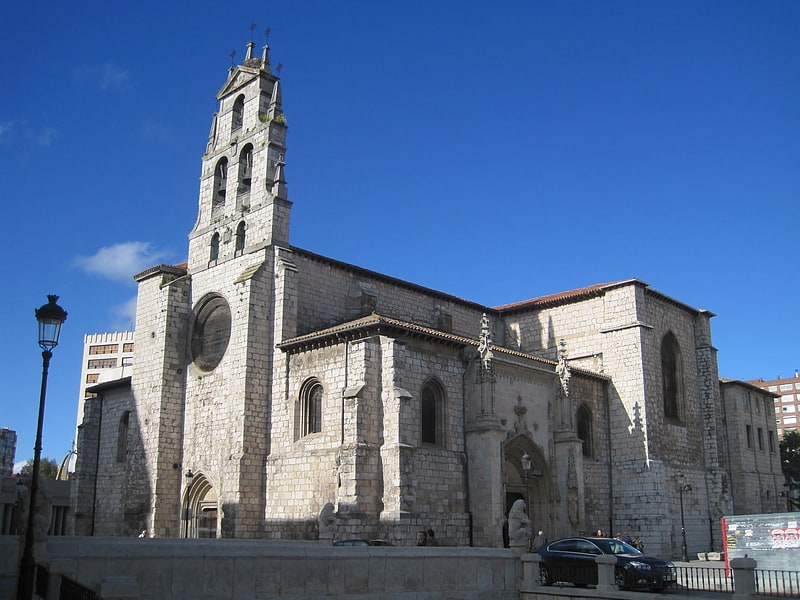
Catholic church in Burgos, Spain. Iglesia de San Lesmes Abad is a Roman Catholic church in Burgos, Spain.
It is located in the Plaza de San Juan, in front of the Public Library, adjacent to the Camino de Santiago. Built in the Gothic style in the 14th century, it contains the remains of Adelelmus of Burgos, the patron of the city. The church underwent restoration in 2012–13.[9]
Address: Plaza San Juan, 33, 09004 Burgos
San Gil Abad

Church in Burgos, Spain. Iglesia de San Gil Abad is a church in Burgos, Spain. It dates to the 14th-15th century. It was declared a Bien de Interés Cultural site by decree of 3 June 1931.[10]
Address: San Gil 12, Burgos
Convento de Santa Dorotea

Convent in Burgos, Spain. The Convento de Santa Dorotea is an Augustinian nun's convent in Burgos, Castile and León, Spain. It is a Gothic construction, and dates back to 1387, when Dorotea Rodriguez Valderrama, along with other devout women formed a nun's community at the old church of Santa Maria la Blanca. The community adopted the rule of St. Augustine in 1429 with the support of Bishop Pablo de Santamaría. In 1457 they moved to the church of San Andrés, until in 1470 they settled in the current location in the barrio of San Pedro y San Felices. Among the many benefactors who favored the monastery was King John II of Castile. Tombs of note include those of Alonso de Ortega, and Bishop Juan de Ortega, the work of Nicholas de Vergara, 1516.[11]
Santa María la Real y Antigua de Gamonal

Building in Burgos, Spain. Iglesia de Santa María la Real y Antigua de Gamonal is a church in Burgos, Spain. The Gothic structure dates to the 14th century, although there is evidence of an earlier church dating back to the eleventh century, when King Alfonso VI moved his seat from the destroyed city of Oca of the Auca diocese in 1075. It became a Bien de Interés Cultural listed building on 3 June 1931.[12]
Address: Calle Vitoria, 224, 09007 Burgos
Santa Gadea

Also known as: Iglesia de Santa Águeda
Santa Gadea is a church dedicated to Saint Agatha in Burgos, Spain. The church is famous in history and literature for being the site where Rodrigo Díaz de Vivar at the behest of the Castilian Cortes, forced Alfonso VI to swear an oath that he was not an accomplice in the death of his brother, Sancho while he was besieging Zamora. Es el de la jura de Santa Gadea is the most notable Spanish medieval romance about this event.
The church today is not the same as it was at the time of the swearing of the famous oath, but the place where the event took place is nevertheless marked by an inscription on a plate, positioned on the outside wall beside the church door.[13]
Address: Calle Sta. Águeda, 12, 09003 Burgos
San Cosme y San Damián

Parish church in Burgos, Spain. Iglesia de San Cosme y San Damián is a Catholic parish church in Burgos, Spain, on the left bank of the Arlanzón River. It was built in the sixteenth century with a combination of the Late Gothic and Renaissance styles. It was a burial place of featured artists of the time. The porch on the north side was designed by Juan de Vallejo in 1552, with a triumphal arch with medallions of John the Baptist and John the Evangelist in the spandrels and fine fluted columns. The massive tower of the church, of the classicist baroque style, was added in 1621 by Gabriel de Cotero.[14]
Address: Calle San Cosme, 21, 09002 Burgos
San Lorenzo el Real

Building in Burgos, Spain. Iglesia de San Lorenzo el Real is a Baroque church in Burgos, Spain. It is located on Calle Almirante Bonifaz. San Lorenzo was originally a Jesuit church, built between 1684 and 1694 to replace an earlier building of more modest proportions. The work was financed and sponsored by Francisca de San Vítores and erected by Bernabé de Hazas and Francisco del Pontón. After the expulsion of the Jesuits in the late eighteenth century, the church became a parish church. Since its creation in 1945, the church has been the seat of the Brotherhood of Coronación de Espinas y de Cristo Rey.[15]
Address: Calle del Almirante Bonifaz, 09003 Burgos